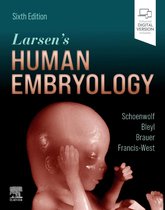Summary cases Embryology BBS1005
By: Myrte van de Bergh
1
,Inhoudsopgave
Case 1 Age and Reproduction ........................................................................ 3
Case 2 Getting pregnant .............................................................................. 20
Case 3 Cell differentiation ............................................................................ 31
Case 4 The cell cycle ..................................................................................... 47
Case 5 Implantation and twin development ................................................ 64
Case 6 Progeria ............................................................................................ 76
Case 7 Somitogenesis and segmentation ..................................................... 87
Case 8 Gut development ............................................................................ 105
Case 9 Limb development and apoptosis ................................................... 120
Case 10 Sex differentiation ........................................................................ 134
Case 11: Foetal development … to be finished after birth?! ...................... 149
Case 12 ....................................................................................................... 167
2
,Case 1 Age and Reproduction
Brainstorm:
Gametogenesis = the process of synthesizing gametes/germ (egg and sperm cells) →
pathway of the oocytes
Factors: Age, sex, modifications (histones etc.)
Diseases: Trisomie 21
Epigenetic patterns
DNA repair mechanisms
Mutations: frameshifting, missense, insertion, duplication, transversion, silent, deletion,
nonsense, substitutions, cross-over
Mitosis/meiosis
Structure of DNA
Epigenetics: histone modification, DNA methylation/acetylation
Problem statement:
How factors influence reproduction?
Learning goals:
1- The structure of DNA and the basics of replication
2- Physiology of gametogenesis, difference between male and female
• The effect of age on gametogenesis
3- Epigenetics and the influences on reproduction (histone modification/ DNA methylation)
• Epigenetics’ pattern?
4- Repair mechanisms of mutations
5- The process of meiosis (focus on mutations and the impact of them)
6- Find three examples for congenital diseases
3
, 1. The structure of DNA and the basics of replication
Revision of BBS1001 Case 2
The structure of DNA
A DNA molecule consists of two long antiparallel polynucleotide chains composed of four
types of nucleotide subunits
- The nucleotide subunits consist of a phosphate group, a deoxyribose sugar and a
nitrogenous base
- Either the bulkier two ring purines Adenine and Guanine, or the smaller single ring
pyrimidines Cytosine and Thymine. There is complementary base pairing; A to T 2 hydrogen
bonds), G to C 3 hydrogen bonds).
- The sugar and phosphate group form the backbone of the DNA. The phosphate group on
C5 of the deoxyribose sugar and the hydroxyl group on C3 on the sugar of a different
nucleotide can form phosphodiester bonds to create the backbone
- This gives the DNA strand a polarity- one backbone will have the phosphate on C5 at the
end, and thus, be referred to as the 5' end, whilst the other will have the hydroxyl group
onC3andbethe3'end.
- The complementary base pairing gives rise to double helix 3D structure of DNA, as each
pair of
nucleotides is the same width. The helix goes through one full rotation every ten pairs
- The structure of DNA lead to the theory of semi conservative replication- as each strand
was exactly complementary to the other, they could both act as a template for a new
daughter strand.
4






